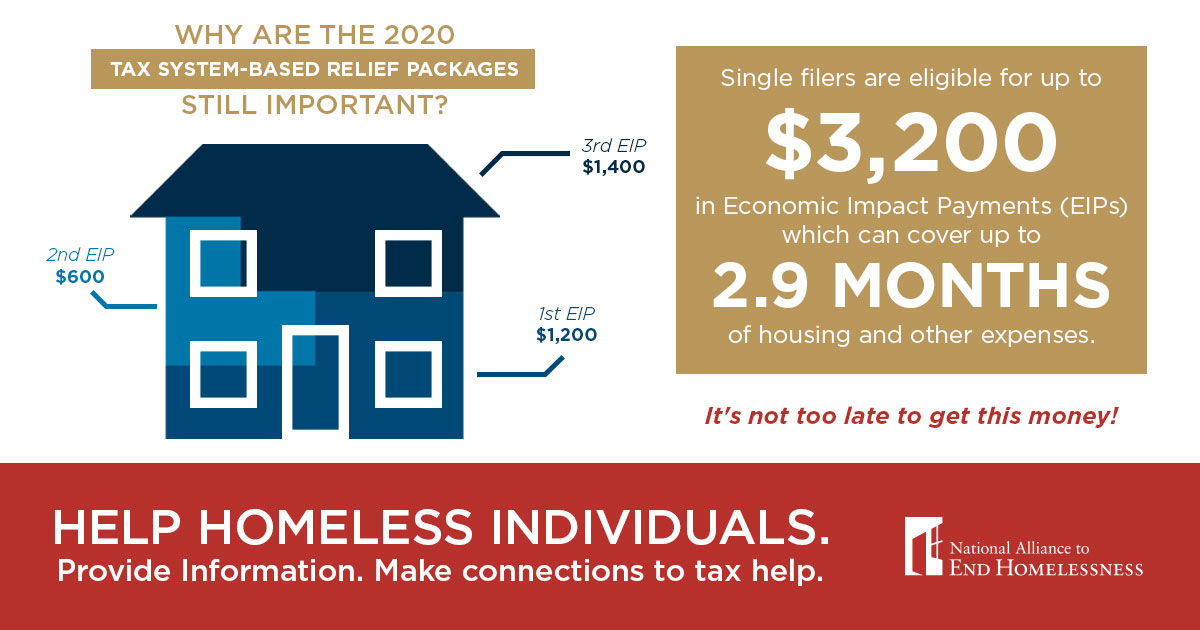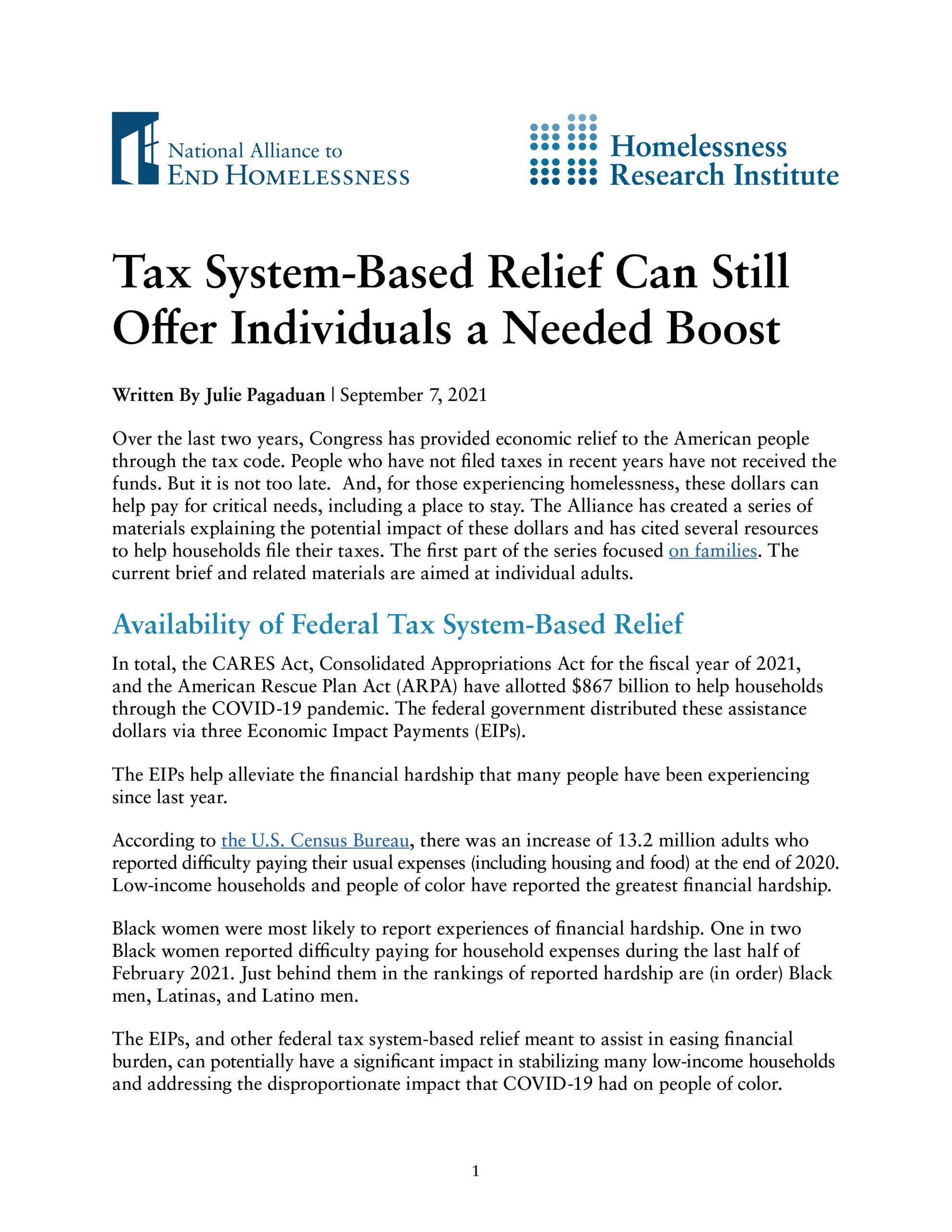Written By Julie Pagaduan | September 7, 2021
The Alliance has created a series of materials explaining the potential impact of these dollars and has cited several resources to help households file their taxes. The first part of the series focused on families. The current brief and related materials are aimed at individual adults.
Availability of Federal Tax System-Based Relief
In total, the CARES Act, Consolidated Appropriations Act for the fiscal year of 2021, and the American Rescue Plan Act (ARPA) have allotted $867 billion to help households through the COVID-19 pandemic. The federal government distributed these assistance dollars via three Economic Impact Payments (EIPs).
The EIPs help alleviate the financial hardship that many people have been experiencing since last year.
According to the U.S. Census Bureau, there was an increase of 13.2 million adults who reported difficulty paying their usual expenses (including housing and food) at the end of 2020. Low-income households and people of color have reported the greatest financial hardship.
Black women were most likely to report experiences of financial hardship. One in two Black women reported difficulty paying for household expenses during the last half of February 2021. Just behind them in the rankings of reported hardship are (in order) Black men, Latinas, and Latino men.
The EIPs, and other federal tax system-based relief meant to assist in easing financial burden, can potentially have a significant impact in stabilizing many low-income households and addressing the disproportionate impact that COVID-19 had on people of color.

Breakdown of What the Economic Impact Payments Cover
The maximum amount that an individual can receive through the three Economic Impact Payments and is $3,200. Below is the breakdown of each payment.
| Federal Payment | Maximum Amount Awarded to Single Adults |
| 1st EIP | $1,200 |
| 2nd EIP | $600 |
| 3rd EIP | $1,400 |
| Total Tax Breaks Awarded: $3,200 | |
Nationally, the average median cost of rent (FMR) plus major expenses for an individual renting a 1-bedroom apartment is $1,103.73. The EIP distributions cover 2.9 months of rent and other major expenses (based on national-level averages).
The visualization below shows the average amount of months that the EIP can cover for each state based on local living costs.
Childless Earned Income Tax Credit (EITC)
In addition to the EIPs, the 2021 ARP Act temporarily enhanced the Earned Income Tax Credit for “childless” adults (people who do not claim any children on their tax returns). Individuals will reap the benefits when they file their 2021 taxes next year.
The amount an individual received from the EITC is dependent on their earned income. The credit targets people who have been employed during the year (even if they only worked part-time and/or part of the year) and are low-income. To review how much an individual would receive through the EITC, visit the Center on Budget and Policy Priorities’ article on Policy Basics: The Earned Income Tax Credit to use their EITC calculator.

For the 2021 tax year, an individual’s maximum tax relief through the Childless EITC increased from $543 to $1,502. The minimum age for filers also decreased from 25 to 19 years old, allowing far more young adults to participate. When coupling the EITC and the EIPs tax credit, coverage of major household expenses increases to 4.3 months. This is an additional 1.4 months.
How to Claim Economic Impact Payments
The EIP requires that individuals file their taxes.
The IRS Free File tool will be available on the IRS website until October 15, 2021. Individuals can still file their taxes after this deadline, but the federal government strongly encourages everyone to file as early as possible and late fees could accrue.
Individuals who did not receive their 1st and 2nd EIP, or the full amount they were eligible for, can still claim their EIPs via the 2020 Recovery Rebate Credit and by filing a 2020 tax return form.
Resources for Moving Forward
Agency providers and advocates seeking to help people experiencing homelessness access tax credits can learn more about EIPs and the EITC via the following resources:
- The IRS has informational materials about the 1st EIP, 2nd EIP, 3rd EIP, and EITC for childless workers.
- Additional government agency explainers are available via The White House and the Consumer Financial Protection Bureau.
- The National Low Income Housing Coalition’s (NLIHC) produced “Guidance for Helping People Experiencing Homelessness Access Their Economic Impact Statements.”
1 The average monthly costs for renting a 1-bedroom housing unit and major expenses were estimated using the U.S. Department of Housing and Urban Development’s (HUD) 2021 rental data on the 50th percentile for Fair Market Rents across the U.S. and the U.S. Bureau of Labor Statistics’ (BLS) 2020 Consumer Expenditure Survey Public Use Microdata Interview Files. Major expenses include the cost of food, transportation, utilities, and medical expenses for a typical household. Major expenses for each state were weighted according to the Missouri Economic Research and Information Center’s (MERIC) Cost of Living Data Series.
2 The EITC is a refundable tax credit and is the largest need-tested anti-poverty program that provides cash support to families. Like the EIP, households must file their tax return to receive the EITC. However, you must have an income to report to be eligible for this tax break. ARPA extended the EITC to “childless” adults. Based on a Congressional Research Service report, this is defined as workers without children or having non-qualifying children that cannot be claimed as dependents. ARPA increased the maximum amount that a “childless” adult can receive from $543 to $1502. Low-income taxpayers often qualify for the maximum amount. The bill also dropped the eligibility age from 35 to 19 years old so young adults can take advantage of this federal tax break too.

